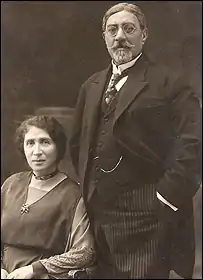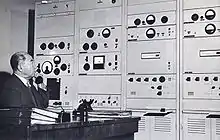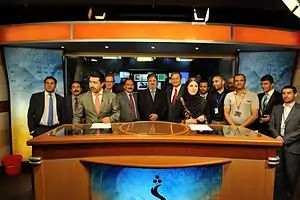Mass media in Afghanistan
The mass media in Afghanistan includes printing, broadcasting, and digital. It is mainly in Dari and Pashto, the official languages of the nation. According to the Attorney General's Office of Afghanistan, "there are 1,879 active media outlets in Afghanistan which are called as one of the main achievements of the country in the past 18 years."[1]
In 2019, Reporters Without Borders listed the media environment of Afghanistan as 121 out of 179, with 1st being most free.[2][3] Journalists in the country operate in one of the world's most complex and contested information environments. At times, the lines between propaganda, intelligence, and journalism blur, and some journalists covering Taliban activities have been accused of treachery or arrested by agents of the National Directorate of Security (NDS), while others have been kidnapped, beaten, or assassinated by Taliban insurgents.[4][5][1][6][7][8]
Journalists in Afghanistan face threat from both the insurgent groups and the Afghan National Security Forces (ANSF). In 2017, the Afghan Journalists Safety Committee (AJSC) claimed that the ANSF accounted for 46% of the attacks on journalists while the Taliban and other Islamic extremists were responsible for the rest.[9][10]
Media history

The first newspaper, Shams-i Nahar (Morning Sun) was published in 1873 during the rule of Sher Ali Khan.[11]
Another newspaper, Siraj-ul-Akhbar (Lamp of the News) was initially published on January 11, 1906, with Abdul-Rauf as editor. After this first and only issue in Persian language, its publication stopped. It was revived in October 1911 by Mahmud Tarzi, the editor and owner of the newspaper who was critical of the friendship between the British Empire and Afghanistan. Mahmud Tarzi became known as the pioneer of Afghan journalism, in 1916 he famously wrote: "Siraj Al Akhbar Afghaniya is neither British, nor Russian nor French nor Italian nor German nor Chinese or Japanese. It is a Muslim newspaper and, in that, it is specifically an Afghan newspaper. Whatever it says, whatever melody it sings, is from an Afghan point of view and stems from the tone of Afghan national dignity." In 1919, under King Amanullah Khan, Aman-i-Afghan (Afghan Peace) replaced Siraj al-Akhbar, serving as an organ of the government, while several smaller private journals appeared under different ministries.[12] Along with these developments, Radio Kabul began broadcasting in 1925, which inaugurated a new era of mass media in the country.[12] The 1964 Constitution of Afghanistan and the Press Law of 1965 provided for freedom of the press, within the boundaries of appropriate behavior. The press was editorially independent from government but was instructed to safeguard the interests of the state and constitutional monarchy, Islam, and public order. Afghan journalism progressed and developed from the 1950s through to the 1970s, though it remained limited.

When King Zahir Shah's government was overthrown in the 1973 coup by his cousin Daoud Khan, approximately 19 newspapers were shut down and media came under severe restriction, ending a period of relative freedom.[13] The first color television broadcasting appeared in 1978.[13] The media fell into the control of Soviet influences during the Democratic Republic of Afghanistan from 1979 to 1992.[14]
Media under the Taliban government was characterized by strict media laws, including the banning of television.[13] The Taliban instigated the destruction of television sets in 1998.[15] People caught with a television in their homes were subject to monetary fines, flogging, or imprisonment. Most media operated from other countries, except for a small area in northern Afghanistan, which had its own television service called Badakhshan Television. It broadcast news and films for around 5,000 viewers for three hours a day.[16][17] All television stations were shut down in 1996 by order of the Taliban,[13] and printed newspapers were forbidden to publish commentary, photos, or readers letters. The radio stations under Taliban control broadcast nothing other than religious programs and selected news. Around 70% of the population listened to its broadcasts.[15] In 2000, the Taliban government launched The Islamic Emirate, an English-language newspaper designed to counteract information produced by the "enemies of Islam".[15] Only Russia, Czech Republic and Serbia had news bureaus based in Kabul due to instability.[13] The Kabul TV center was converted into a military barracks, and journalists were not permitted to work with foreign media.[15] The media environment remained bleak until the overthrow of the Taliban government in late 2001.

The Afghan media has experienced a rapid growth during the Karzai administration, with dozens of TV stations being established around the country. Some of these include Tolo, Ariana Television Network, Lemar, Shamshad, and the state-owned Afghanistan National Television (RTA). Over two hundred radio stations have also been established. As of 2019, there are over 1,000 newspapers, magazines, and other print media.[1] All media flourished under Afghanistan's new rules, though journalists do undergo self-censorship; penalties are still in place for defaming individuals and running material contrary to the principles of Islam.[17]
Some government officials have used their positions to maintain their own communications facilities, as national and local governments own or control several dozen newspapers and many electronic media outlets.[18] A 2004 media law prohibits censorship, but requires registration of periodicals with the Ministry of Information and Culture; in 2005 some 250 periodicals were registered.[18] International organizations have been training new journalists since the fall of the Taliban.[16] However, due to instability in Afghanistan, journalists have been as highly targeted as soldiers, as shown by instances of kidnapping and death threats.[19] An NGO named Nai (meaning flute, an important symbolic instrument for broadcasting) tracks violence against journalists with its Media Watch Data.[20] More than 100 journalists also protested a raid on a private TV station which drew concern of further government interference in reporting.[21]
One of Afghanistan's largest independent news agencies is Pajhwok Afghan News, which was founded in 2004 by Afghan journalists who worked with the Institute for War and Peace Reporting. It has reporters in nearly every province, and publishes stories online in English, Dari and Pashto.[22] Bakhtar News Agency, another wire service, is run by the Afghan government.
Although many fewer Afghan women than men work as journalists, female Afghan reporters and editors are increasingly making their voices heard not just on traditionally "feminine" topics like education and health, but on larger issues affecting Afghanistan, such as the tension between tradition and modernity.[23] Shukria Barakzai founded the weekly bilingual Women's Voice to campaign for women's rights. She was elected to the House of the People (or Wolesi Jirga, the lower house of the National Assembly of Afghanistan), and speaks up for hopes that a better and freer press will lead to strong democracy and civil society.[24] One of the most high-profile government attacks on press freedom occurred in 2008 when presenter Mohammad Nasir Fayyaz of Ariana Television Network was arrested for criticizing members of the cabinet. He was later released without charge.[25] During the Afghan presidential election, 2009 there were some reports of attacks on press freedom.[26] On April 30, 2018, nine journalists lost their lives in an insurgent bombing in Kabul, the deadliest incident against journalists since 2001.[27] By the end of the year a total of 14 journalists and media workers have been killed in Afghanistan.[4]
Newspapers
Afghanistan has nearly 1,500 print media as of 2019.[1] The principal daily newspapers are the state-owned Anis, Arman-e Melli, and the privately owned Afghanistan Group of Newspapers which includes The Daily Outlook Afghanistan (The first Independent English Newspaper of Afghanistan) and The Daily Afghanistan in local languages of Dari and Pashto, Cheragh, founded by first Afghan lady journalist Kathreen Wida in December 2003, Eslah, and The Kabul Times and Khaama Press and Eradeh, Hewad, Ittefaq-e Islam, and Shari'at. The circulation of independent print publications has been confined primarily to the Kabul region. About 500 publications are now registered in the country.[28]
Radio
Radio has long been the most widespread source of information in Afghanistan. Radio broadcasting went into air in 1925 with Radio Kabul being the first station. By the late 1970s nearly every home owned at least one radio, especially in the major cities. As of 2019, the country has 284 radio stations,[1] with AM, FM and shortwave, broadcasting mainly in Pashto and Dari languages. The BBC World Service, Voice of America, Radio Azadi and others broadcast into Afghanistan as an additional source of news, in both Pashto and Dari.[28] List of radio stations in Afghanistan
Television

It was reported in 2019 that Afghanistan has 203 television stations, 96 in Kabul and 107 in other provinces of the country.[1] They include local and international channels.[29] One of this is state-owned RTA TV. Satellite and cable television ownership is growing; Al Jazeera widely seen as a leading source of uncensored information.[30] Many global news channels have local bureau's in Kabul, including: CNN, BBC, Sky News, DD News, and Aljazeera.
With a combination of Afghan news and political programs, original reality TV shows, Bollywood movies and American programs like "24", ARIA TV is the first exclusive channel for children and teenagers, while Tolo TV is Afghanistan's most watched station. Saad Mohseni, chairman of Tolo's parent company, MOBY Group, said Moby's revenues are in the $20 million range and the media company operates at a profit.[31] Lemar TV, which broadcasts in Pashto language, is a sister channel of Tolo. Another channel that is mostly in Pashto is Shamshad TV, which is owned by another Afghan group. Sharq TV is also another TV channel that broadcasts in Pashto in the Eastern zone of Afghanistan, it is owned by Shaiq Network.
Baano TV is women dedicated channel started in July 2017. The channel is available in Kabul & Mazar-e-sharif as well as on all over Afghanistan & middle east via satellite.
ABS "Afghanistan Broadcast System" a part of ACG "Asian Consulting Group" start its DTTV service under the trade name of Oqaab. Oqaab ((meaning “eagle” in Dari)),is a digital broadcasting service that allows users to see television in digital format. Digital TV is an advanced television format that provides a much better picture and sound quality when compared to traditional analog television. Users will continue to receive local channels for free while, coming soon, expanded premium channels will be offered for a low month fee. Today many new TV channels start their Broadcasting via ABS (OQAAB). ANAAR TV was the first Digital TV (DTT) which starts its broadcasting on 31 May 2015 dedicated to technology.
List of Digital TV channels are including but not limited to Anaar TV, Harirood TV (Now Afghanistan TV), Hadees TV, 10 TV, Mashal TV, 11TV, Meshrano Jerga TV (Parliament's 2nd TV channel) and Afghanistan Youth TV.
Internet
Digital media increased rapidly in Afghanistan in the last decade. About 2.69 million online users were reported in 2015.[32] Internet access mainly grew through internet cafes as well as public "telekiosks" in Kabul. A number of online newspapers are available, including Bakhtar News Agency, Khaama Press, and Pajhwok Afghan News.
References
- "Suspects Sentenced To Death For Killing Journalist In Kandahar". TOLOnews. April 16, 2019. Retrieved 2019-04-16.
- "Afghanistan". Reporters Without Borders. Retrieved 2019-04-16.
- "Afghanistan Descends 3 Points On Press Freedom Index". TOLOnews. April 19, 2019. Retrieved 2019-04-19.
- Afghan Journalists: 14 journalists, media workers killed this year. TRT World. September 25, 2018. Retrieved 2019-04-16.
- "Taliban execute Afghan citizen-journalist". Reporters Without Borders. Retrieved 2019-04-16.
- https://www.cjr.org/cover_story/crossfire_in_kandahar.php?page=1
- http://en.rsf.org/afghanistan-hojatullah-mujadadi-nds-kapisa-18-10-2010,38568.html
- http://pulitzercenter.org/blog/untold-stories/afghan-journalist-detentions
- "Violence Against Journalists Surges In Afghanistan In 2017". RFERL. Retrieved 25 July 2017.
- "Afghan journalists 'face increasing attacks and threats' - report". The Guardian. Retrieved 21 January 2015.
- Dupree, Louis (1997). Afghanistan (2nd ed.). Oxford Pakistan Paperbacks. p. 405. ISBN 978-0-19-577634-8.
- Saikal, A., Farhadi, R. & Nourzahanov K. Modern Afghanistan: A History of Struggle and Survival. I.B.Tauris, 2006. ISBN 978-1-84511-316-2.
- Afghanistan media, Press reference.
- Potichnyj, P. J. The Soviet Union: Party and Society. Cambridge University Press, 1988. ISBN 978-0-521-34459-3.
- Dartnell, M. Y. Insurgency Online: Web Activism and Global Conflict. University of Toronto Press, 2006. ISBN 978-0-8020-8553-5.
- World of Information. Middle East review 2003/04. Kogan Page Publishers.
- "Afghanistan Country Profile". BBC News. January 31, 2018. Retrieved 2019-04-19..
- Afghanistan country profile Archived 2014-04-08 at the Wayback Machine. Library of Congress Federal Research Division (2006). This article incorporates text from this source, which is in the public domain.
- Kamalipour, Y. R. & Snow, R. War, Media, and Propaganda: A Global Perspective. Rowman & Little field, 2004. ISBN 978-0-7425-3563-3.
- Nai Media Watch data - violence against journalists.
- Afghan journalists protest raid on TV station ordered by attorney general, International Herald Tribune, April 18, 2007.
- http://pulitzercenter.org/blog/untold-stories/afghanistan-journalism-pajhwok-afghan-news-taliban
- http://www.tampabay.com/news/perspective/breaking-news-and-making-news/1146780
- "The Media Report" 22 June 2006
- http://news.bbc.co.uk/1/hi/world/south_asia/7530568.stm
- http://www.rfi.fr/actuen/articles/116/article_4868.asp
- https://www.aljazeera.com/news/2018/04/dark-day-tributes-journalists-killed-kabul-180430093045680.html
- Afghanistan Press Report 2008 Archived June 23, 2011, at the Wayback Machine, Freedom House.
- "ISAF Spokesman Discusses Progress in Afghanistan". International Security Assistance Force/NATO. July 25, 2011. Archived from the original on July 25, 2011. Retrieved December 6, 2011.
- Poole, E. & Muslims and the News Media. I.B.Tauris, 2006. ISBN 978-1-84511-172-4.
- https://www.newyorker.com/reporting/2010/07/05/100705fa_fact_auletta?currentPage=1
- "Afghanistan". The World Factbook. www.cia.gov. 2015. Retrieved 2017-05-16.